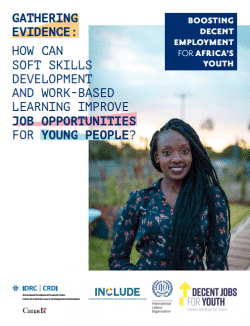
Youth unemployment has been a tough and persistent challenge. The COVID-19 pandemic has further spotlighted young people’s vulnerability and the need for urgent, innovative, and effective youth employment programs. during the design stage.
Solutions for Youth Employment (S4YE) recently published a Knowledge Brief that identifies how . Program teams have used a variety of technology solutions like radio, SMS platforms, and social media as channels of communication to engage young people.
Engaging youth through radio
Radio is a reliable and useful way to communicate with youth who live in areas where internet-based technology systems are not affordable or available. Radio can also overcome literacy issues and language barriers, and is relatively affordable for organizations to utilize as an engagement method.

Africa’s Voices Foundation team members using radio to engage young people in Kenya. Photo: © Africa’s Voices Foundation
For the last five years, S4YE’s partner Africa’s Voices Foundation (AVF) has amplified over 400,000 citizens’ voices through their evidence-to-action programming. AVF has successfully used radio platforms to engage many of these young people. In 2018, AVF joined forces with Mastercard Foundation to test an SMS platform to solicit feedback from youth. AVF mobilized young people in Kenya using the popular local radio station Ghetto Radio.
Ghetto Radio presenters asked listeners what would help them achieve their employment goals. Approximately 1700 youth responded via SMS, helping AVF shape a youth employment event in Nairobi.
Making use of SMS surveys

Educate!’s SMS platform model Photo: © Educate!
S4YE’s partner Educate! tackles youth unemployment in Uganda, Rwanda, and Kenya by providing skills-based education. Educate! incorporated an SMS platform into their distance learning model (which includes radio lessons) to communicate with youth and measure youth comprehension of the courses taught. Youth receive learning prompts and questions via SMS, which allows Educate! to gauge youth learning, as well as hear feedback on the platform and learning experience itself.
During the COVID-19 pandemic Educate! discovered through SMS surveys that many students have had to take on new responsibilities amidst school closures, leaving limited time for learning. This is a challenge related to gender equity, as household responsibilities disproportionately fall to girls. Educate! also learned that boys are more likely to possess their own phones than girls, making it more challenging for female learners to participate. In response to these learnings, Educate! made several program adjustments. They facilitated all-girl conference calls in an effort to create safe spaces for girls to discuss gender-related issues that have come up during the pandemic. Additionally, Educate! developed a second set of remote lessons to radio and SMS later in the day for learners with limited time, conflicting responsibilities, or those who may have to share devices. Furthermore, Educate! connected youth directly to Educate! mentors over the phone for one-on-one, individualized support and to make up missed lessons.
Social media for good

Youth participants of the MYLMI project. Photo: © MYLMI project
The Mexico Youth Labor Market Inclusion (MYLMI) project, which targets low-income youth and helps connect them with quality formal employment opportunities, has been using social media as a way to more fully engage youth.
Typically, MYLMI relies on SMS to remind youth about project activities and to take surveys. But the team and project partners developed a communications and outreach strategy that leveraged social media platforms such as Facebook and YouTube to disseminate engaging, entertaining content, such as graphics and videos that may not be sharable by SMS. By using social media in conjunction with SMS reminders, the team was able to remind students about project activities, promote economic incentives for completed surveys, and incorporate their feedback into the program design and evaluation. This approach helped to increase participation rates across project interventions and surveys.
S4YE’s partners have placed youth voice at the heart of their youth employment programs by adopting the most suitable methods based on local norms. Since employment practitioners can learn from and adapt these collaborative approaches, S4YE will be launching a new series online called “How To Notes.” The first two publications will provide a quick step-by-step guide for practitioners and policymakers to develop an effective communication strategy using technology.



